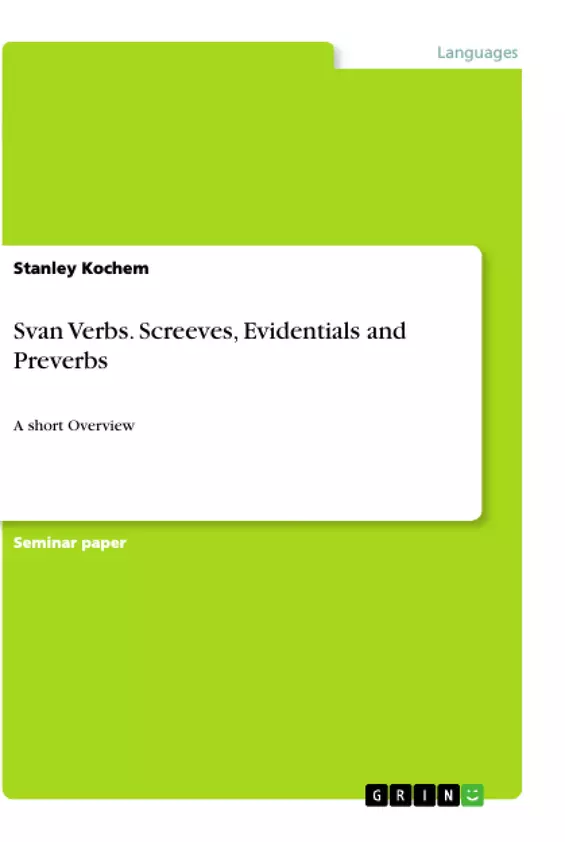This paper deals with Svan Verbs. This work attempts to approach the matter more practically by classifying and describing all the given verbs from the set of data into the patterns. The focus lies on the morphology and the classification of verbs and not on its usage or frequency.
All the verb forms used in this paper are either elicited by a native speaker of Svan with whom a class of students from the University of Bamberg worked for two continuous terms, or sorted out of a few hours long recorded dialogue between this very speaker of the Svan language and an elderly woman from and in a Svan village, accessible as an ELAN-file. The Svan-English Dictionary by Gudjedjiani and Palmaitis serves as a scientific aid, for research topics sparsely outlined in the first term paper, especially.
Inhaltsverzeichnis (Table of Contents)
- Introduction
- Overview of the different prefixes and preverbs
- The different screeves
- The Present Screeve
- The Imperfect Screeve
- The Perfect Screeve
- Further screeves
- Evidentials
- The Masdar
- Further observations
- Conclusion
Zielsetzung und Themenschwerpunkte (Objectives and Key Themes)
This paper focuses on Svan verbs, extending a previous work by classifying and describing the morphology of these verbs from a data set. The primary aim is to analyze and categorize verb forms based on their morphology, providing a practical approach to the topic. The focus is on morphology and classification, rather than on usage or frequency.
- Morphology and classification of Svan verbs
- Analysis of prefixes and preverbs
- Exploration of different screeves and their characteristics
- Examination of evidentials in Svan verbs
- Understanding the role of morphology in Svan verb structure
Zusammenfassung der Kapitel (Chapter Summaries)
- Introduction: This chapter introduces the paper as a continuation of previous work on Svan verbs. It outlines the scope of the study, focusing on the morphology and classification of verb forms from a data set. The sources of data, including elicited forms from a native speaker and recordings of a dialogue, are also presented.
- Overview of the different prefixes and preverbs: This section discusses the different prefixes and preverbs found in Svan morphology. It highlights the semantic fields associated with these morphemes and provides examples of their usage. The chapter includes a list of preverbs and prefixes with example verbs and translations.
- The different screeves: This chapter explores the concept of screeves, a term used to describe sets of verb forms that differ only in person and number. It discusses the 13 screeves recognized in Svan, classified into three groups. The chapter provides a detailed breakdown of each screeve group.
- Evidentials: This section focuses on evidentials, a type of grammatical marking that indicates the source of information or the speaker's confidence in a statement. It explores the role of the masdar, a type of noun form that functions as an evidential marker in Svan.
Schlüsselwörter (Keywords)
This paper delves into the morphology and classification of Svan verbs, examining prefixes, preverbs, and different screeves. It also explores evidentials, specifically the role of the masdar in Svan grammar. Key terms include: Svan verbs, morphology, prefixes, preverbs, screeves, evidentials, masdar, data analysis, and linguistic classification.
- Quote paper
- Stanley Kochem (Author), 2020, Svan Verbs. Screeves, Evidentials and Preverbs, Munich, GRIN Verlag, https://www.grin.com/document/999795



